This is the sixth in a series of Friday posts on congregational song.
I had blogged a devotional reading that ended in my Advent hymn, Come, Our Lord!. The same day I received an email from a lady who kindly said that she liked the words to the hymn but wished it would have been set to a different tune. The hymn tune is OLD BLACK JOE, and she was offended by the music of minstrelsy.
Her response is understandable. A number of the hymn tunes I use have had such unsavory associations. No example is more striking than AUSTRIAN HYMN. The music was a classical melody by Joseph Haydn, but it served as the national anthem of Nazi Germany (under the title, “Deutschlandlied”). For those who suffered during that era, that tune surely aroused horrific visions of militant hatred. But today the tune bears glorious, Christ-honoring words, such as the classic hymn, Praise the Lord! Ye Heavens, Adore Him, and Fred Kaan’s moving translation, Christ Is Risen, Christ Is Living, as well as my See the Seed of Faith.
While I understand objections to using such tunes, I make no apologies for doing so. All music is God’s music, created by Him for His glory. Evil creates nothing. It is a void, a poverty, an absence of God. It can only pervert God’s good creation.
But God did not abandon His marvelous creation because evil corrupted it. He did not abandon me. He is redeeming this beautiful world and all that sin has tainted. As His grateful child and His servant, I am part of His redemption process. For me, that includes redeeming God’s music.
One of my favorite sources of hymn tunes is folk tunes. They have a creative variety, a warmth, and a life-centeredness that I find charming and irresistible. And in a day when much of the music we hear is far too complex for congregational use, folk tunes are often very singable and people-friendly. They may have to be revised and adapted to work well as hymn tunes, but the raw material is there. (And I am careful to only adapt tunes old enough to be in the public domain. I always avoid copyrighted melodies.)
A folk song about a man who accidentally killed his wife became As You Love, a Maundy Thursday hymn. Ephesians 1 began as a drinking song. A Life of Thanksgiving was a bawdy ballad. By Faith started life as a sea chantey. And numerous other hymns borrowed tunes from folk songs about war, love, personal loss, or ordinary daily life; hymns such as O Living God, A Thankful Heart, All We Need, God Is Speaking, and God Is Working All Around You.
Experience has proven time and again that God’s powerful truth transforms the musical vehicles that carry it. His praise sanctifies the vessels that bear it; that is, it sets those vessels apart for His use. All music is God’s music, and He is reclaiming it to proclaim His glory, His grace, and His good news for all people. We, His servants in music, are privileged to work with Him in this. We look forward to the day when every song will sing of Him alone.
